Updated on April 2023
What is a carbon steel wok?
Wokware is reader supported. When you buy through links on our site, we may earn an affiliate commission. Learn Here.

A carbon steel wok is nothing but a wok made of carbon steel used for high heat cooking techniques mainly stir fry. Let's understand what is a wok and carbon steel separately.
Content:
- What is a carbon steel wok?
- Types of carbon steel wok
- Sizes of carbon steel wok
- Round vs flat Bottom
- Non-Seasoned vs pre-seasoned
- seasoning the wok
- using it for the first time
- Best oil to season the wok
- stove top to use for carbon steel wok
- Cleaning the wok
What is a Wok?
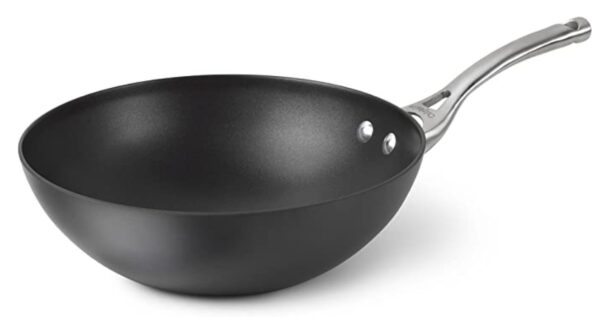
A wok pan, also known simply as a wok, is a versatile and traditional round-bottomed cooking pan that originated in China. It is a key piece of cookware in many Asian kitchens and is widely used for stir-frying, deep-frying, searing, boiling, and other high-heat cooking techniques.
What is Carbon Steel?
Carbon steel is a type of steel that primarily consists of iron and carbon, with trace amounts of other elements. It is a versatile and widely used material in various industries due to its excellent properties, including strength, durability, and affordability. Carbon steel is commonly used in manufacturing, and kitchenware, including woks.
What is a Carbon Steel Wok?
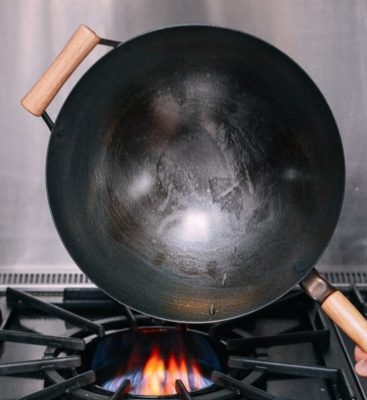
A carbon steel wok is a type of cookware that is specifically designed for stir-frying and other high-heat cooking methods. Carbon steel woks are widely used in Asian cooking, particularly in Chinese, Thai, and Indian cuisines. They are prized for their ability to create a smoky and charred flavor in stir-fried dishes, as well as their versatility in cooking a wide range of ingredients, from meats and vegetables to noodles and rice.
Carbon steel woks have a unique shape, typically featuring a deep, round-bottomed pan with high sloping sides and a long handle or loop handle for easy tossing and stirring. Some carbon steel woks also come with a flat bottom, which is suitable for use on modern induction stovetops.
Best Carbon Steel Wok Recommended by Wokware
Mammafong 14 inch Traditional Hand Hammered Round Bottom Carbon Steel Pow Wok Set
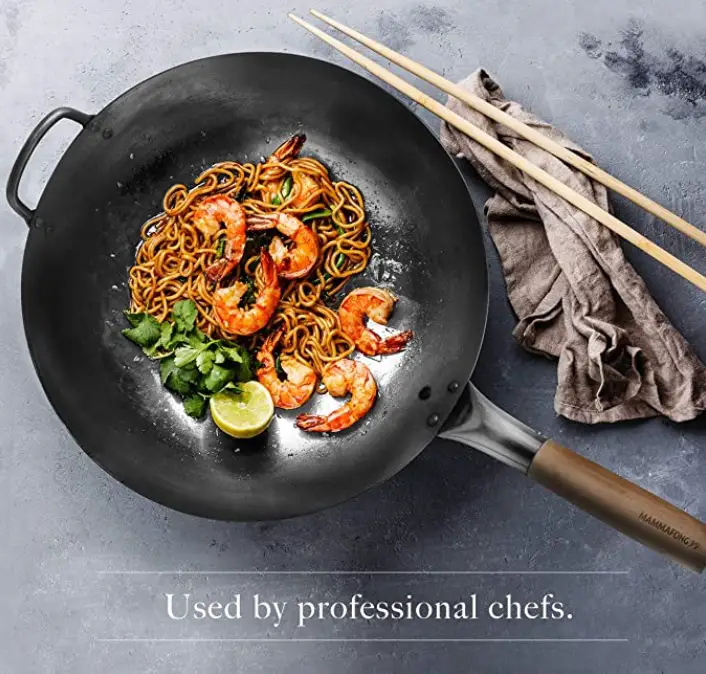
Types of Carbon Steel Wok
There are various types of carbon steel woks available in the market, each with its own unique features and characteristics. Here are some common types:
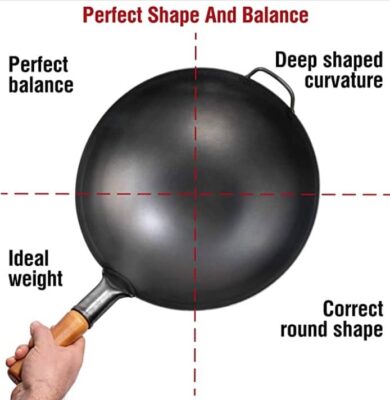
- Traditional Round-Bottom Wok: This is the most traditional and authentic type of carbon steel wok, characterized by its round-bottom shape. It is designed to be used with a wok ring or wok stand to provide stability on a gas stove or outdoor burner. Traditional round-bottom woks are known for their ability to distribute heat evenly, making them ideal for high-heat stir-frying.
- Flat-Bottom Wok: This type of carbon steel wok features a flat bottom, making it suitable for use on modern stovetops, including electric and induction stoves, without the need for a wok ring or stand. Flat-bottom woks are more stable and easier to handle, but may not heat as evenly as traditional round-bottom woks.
- Cantonese Wok: Also known as a "pow wok" or "Peking wok," the Cantonese wok is a type of carbon steel wok with a long handle and a small loop handle on the opposite side. It is designed for one-handed tossing and flipping of ingredients, which is a common cooking technique in Cantonese cuisine. Cantonese woks are typically flat-bottomed and versatile for various cooking methods.
- Mandarin Wok: The Mandarin wok is similar to the Cantonese wok in shape, but it is typically larger and has a shorter handle. It is commonly used in northern Chinese cuisine for cooking large quantities of food, such as for family gatherings or banquets.
- Seasoned and Unseasoned Woks: Carbon steel woks can come seasoned or unseasoned. Seasoned woks are pre-seasoned with a layer of oil or seasoning, which helps to develop a natural non-stick patina over time with use. Unseasoned woks require seasoning before use, which involves coating the wok with oil and heating it to create a non-stick surface.
These are some of the common types of carbon steel woks available in the market, each with its own unique features and advantages. The choice of wok type depends on personal preference, cooking style, and the type of stove or heat source available.
How to measure a carbon steel wok?

Measuring a carbon steel wok is typically done by measuring the diameter or the size of the wok. Here are some steps to measure a carbon steel wok:
- Diameter: The diameter of a wok is typically measured across the widest point of the cooking surface, from one edge to the other, passing through the center of the wok. Use a measuring tape or ruler to measure the diameter of the wok in inches or centimeters. For example, if the measuring tape reads 12 inches or 30 centimeters, then the wok is 12 inches or 30 centimeters in diameter.
- Depth: The depth of a wok is measured from the flat bottom of the wok to the top edge or rim. Use a ruler or measuring tape to measure the vertical distance from the bottom of the wok to the top rim. This measurement is important to determine the cooking capacity and versatility of the wok.
- Handle Length: If the wok has a handle, you may also measure the length of the handle. Measure from the point where the handle is attached to the wok to the end of the handle. This measurement is useful to determine the handle's length and whether it will be comfortable to handle during cooking.
When measuring a carbon steel wok, it's important to measure accurately and use consistent units (e.g., inches or centimeters) to ensure that you choose the right size for your cooking needs. Wok sizes can vary by brand and manufacturer, so it's always best to refer to the specific measurements provided by the manufacturer or seller to ensure an accurate measurement.
Sizes Of Carbon Steel Wok
Carbon steel woks come in various sizes, ranging from small to large, to accommodate different cooking needs and preferences. Here are some common sizes of carbon steel woks:

- 10-12 Inches: These are smaller-sized woks, suitable for individuals or small families. They are lightweight and easy to handle, making them ideal for quick stir-frying and other high-heat cooking techniques. Smaller woks are also suitable for those with limited kitchen space or smaller stovetops.
- 13-14 Inches: These are medium-sized woks, commonly used in most households. They are versatile and suitable for cooking for a moderate-sized family or a small gathering. Medium-sized woks provide a good balance between cooking capacity and ease of handling, making them a popular choice for everyday cooking.
- 15-16 Inches: These are larger-sized woks, suitable for cooking larger quantities of food, such as for parties, gatherings, or commercial use. They have a larger cooking surface area, allowing for more ingredients to be cooked at once, making them ideal for large-scale cooking or catering.
- 17 Inches and above: These are extra-large woks, commonly used in professional kitchens or for commercial cooking purposes. They are designed for high-capacity cooking, such as in restaurants, hotels, or catering services. Extra-large woks are heavy and require more storage space, but they offer a large cooking surface area and can handle large volumes of ingredients.
The size of the wok you choose will depend on your cooking needs, the number of people you usually cook for, and the available space in your kitchen. Smaller woks are more suitable for individual or small-family cooking, while larger woks are ideal for larger gatherings or commercial use. It's important to choose a size that fits your needs and allows you to comfortably handle and cook your desired dishes.
Round Vs. Flat Bottom carbon steel wok
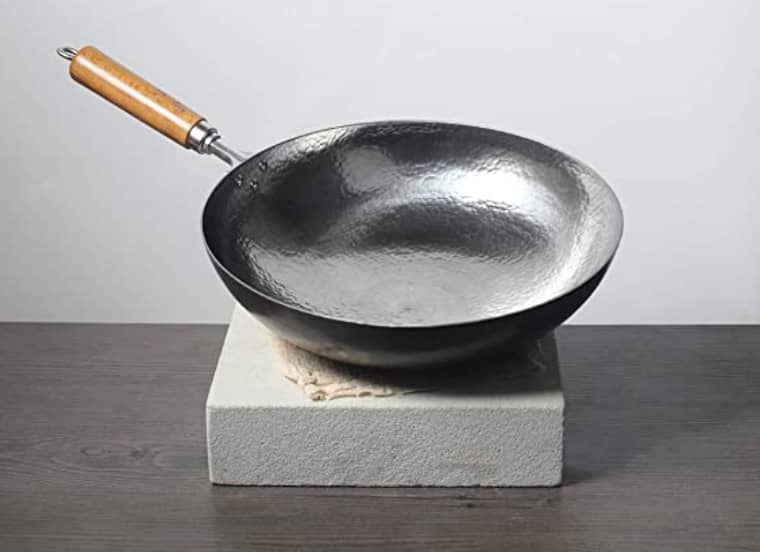
When it comes to carbon steel woks, there are two main types of bottoms: round and flat. Both have their advantages and are suitable for different cooking techniques and stovetops. Let's take a closer look at the differences between round and flat bottom carbon steel woks:
Round Bottom Carbon Steel Wok:
- Traditional design: Round bottom woks are the traditional style commonly used in Asian cooking. They have a curved shape that allows for easy tossing and stirring of ingredients, making them ideal for stir-frying and other high-heat cooking techniques.
- Better heat distribution: The round shape of the wok allows for better heat distribution, as the heat is concentrated at the bottom and gradually decreases towards the sides. This makes round bottom woks well-suited for quick cooking over high heat, which is essential for achieving the characteristic smoky flavor of stir-fried dishes.
- Requires a wok ring or wok stand: Round bottom woks need a wok ring or wok stand to keep them stable on a flat stovetop burner. The wok ring or stand elevates the wok and allows the flames to reach the sides of the wok, ensuring even heat distribution.
- Suitable for outdoor cooking: Round bottom woks are also popular for outdoor cooking, such as on a gas or charcoal grill, as they can be easily positioned over an open flame.
Flat Bottom Carbon Steel Wok:
- Versatile and stable: Flat bottom woks have a flat base that provides stability on any stovetop, including electric, induction, and flat gas stoves, without the need for a wok ring or stand. They can be used directly on the stovetop without any additional accessories, making them more convenient for many modern kitchens.
- Better contact with the heat source: Flat bottom woks have better contact with the heat source due to their flat base, which allows for more efficient heat transfer. This can result in faster and more even cooking, making flat bottom woks suitable for a wide range of cooking techniques, including stir-frying, deep-frying, searing, and more.
- More space for ingredients: The flat bottom of the wok provides more space for ingredients to spread out, allowing for better searing and browning. It also makes it easier to simmer sauces and cook dishes with more liquid, as the flat surface prevents excessive evaporation.
- Easier to store: Flat bottom woks are typically easier to store as they can stand on their own without the need for a wok ring or stand, making them more space-efficient in modern kitchens.
In summary, round bottom carbon steel woks are traditional and ideal for high-heat stir-frying, while flat bottom carbon steel woks are versatile, stable, and suitable for various cooking techniques on different stovetops. Choose the one that best fits your cooking style, preferences, and stovetop setup.
Non-seasoned Vs. Seasoned Carbon Steel Wok
When choosing a carbon steel wok, you may come across options for non-seasoned and pre-seasoned woks. Here are some points to consider when deciding between the two:

Non-Seasoned Carbon Steel Wok:
- Requires seasoning: Non-seasoned carbon steel woks need to be seasoned before use to create a natural non-stick surface and to protect the wok from rusting. Seasoning involves applying a layer of oil and heating the wok to high temperatures, allowing the oil to polymerize and form a protective coating.
- More work upfront: Seasoning a non-seasoned carbon steel wok requires some effort and time to achieve a proper seasoning layer. Multiple rounds of seasoning may be needed to fully develop the non-stick surface, which can be a bit time-consuming.
- Customizable seasoning: Seasoning a non-seasoned wok allows you to customize the seasoning process to your liking, using the oil of your choice and controlling the seasoning level. This can result in a wok that is tailored to your cooking preferences and habits.
- May require regular maintenance: Non-seasoned carbon steel woks may require ongoing maintenance, such as regular re-seasoning, to maintain the non-stick surface and prevent rusting.
Pre-Seasoned Carbon Steel Wok:
- Ready to use: Pre-seasoned carbon steel woks come already seasoned from the manufacturer, so they are ready to use right out of the box. This can save you time and effort compared to seasoning a non-seasoned wok.
- Consistent seasoning: Pre-seasoned woks have a consistent and even seasoning layer applied by the manufacturer, which may result in a more uniform non-stick surface compared to seasoning a wok yourself.
- Lower maintenance: Pre-seasoned woks may require less maintenance compared to non-seasoned woks, as the initial seasoning is already done by the manufacturer. However, some maintenance may still be needed to maintain the non-stick surface over time.
Ultimately, whether to choose a non-seasoned or pre-seasoned carbon steel wok depends on your personal preferences and how much time and effort you are willing to invest. Non-seasoned woks offer customization and the satisfaction of seasoning your own wok, while pre-seasoned woks provide convenience and may require less maintenance. Consider your cooking style, experience with seasoning cookware, and desired level of involvement in the seasoning process when making your decision.
Seasoning a carbon steel wok
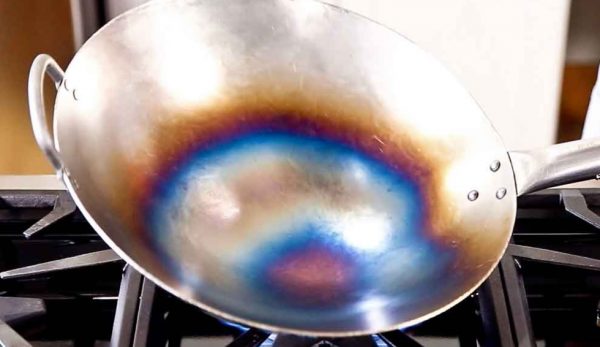
Seasoning a carbon steel wok is a crucial step to create a non-stick surface, prevent rust, and enhance the flavor of your dishes. Here are the steps to season a carbon steel wok:
- Clean the Wok: Before seasoning, wash the wok with warm water and a mild dish soap to remove any dirt, dust, or manufacturing residue. Use a scrub brush or scouring pad to clean the interior and exterior of the wok thoroughly. Rinse off the soap residue and pat dry with a clean towel.
- Heat the Wok: Place the clean and dry wok on a stovetop burner and turn the heat to medium-high or high heat. Allow the wok to heat up until it starts to smoke. This high heat will open up the pores of the carbon steel and prepare it for seasoning.
- Apply Oil: Once the wok is hot, use tongs or a heat-resistant brush to apply a thin, even layer of oil to the interior surface of the wok. You can use high smoke-point oils like vegetable oil, canola oil, or flaxseed oil for seasoning. Avoid using low smoke-point oils like olive oil or butter as they can burn and create a sticky residue.
- Spread Oil: Use a paper towel or a piece of cloth to spread the oil all over the interior surface of the wok, including the bottom, sides, and rim. Be careful as the wok will be hot. The oil will start to smoke and may create fumes, so ensure proper ventilation in your kitchen.
- Heat and Cool: Continue to heat the oiled wok on high heat for a few minutes, allowing the oil to penetrate the pores of the carbon steel. You may notice the color of the steel changing, which is a sign of seasoning. Turn off the heat and let the wok cool down completely.
- Wipe Off Excess Oil: Once the wok has cooled down, use a clean paper towel or cloth to wipe off any excess oil from the surface of the wok. The seasoning process should leave a thin, even layer of seasoned oil on the wok, creating a protective barrier against rust and providing a non-stick surface for cooking.
- Repeat the Process: You may need to repeat the seasoning process 2-3 times to build up a good seasoning layer on your carbon steel wok. Each time you season, the wok will become darker and develop a smoother, non-stick surface.
Note: After seasoning, it's important to maintain the seasoning by avoiding harsh soaps or abrasive scrubbers when cleaning the wok. Instead, use hot water, a soft cloth, or a gentle brush to clean the wok, and dry it thoroughly after each use to prevent rust.
Seasoning a carbon steel wok is an ongoing process, and the more you use and care for your wok, the better the seasoning will become, resulting in a well-seasoned wok that will last for years and provide excellent cooking performance.
How to use a carbon steel wok for the first time?
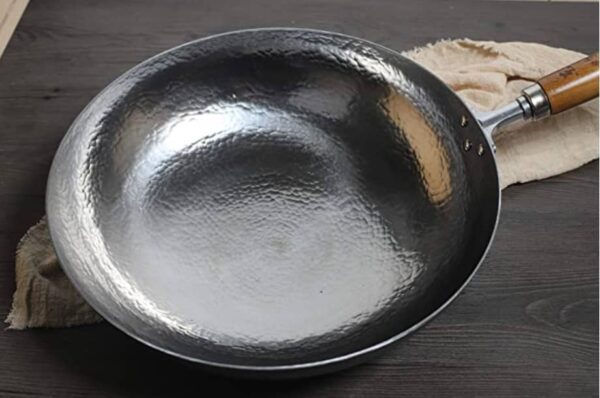
Using a carbon steel wok for the first time can be an exciting experience. Here are some steps to help you get started:
- Wash the Wok: Before using your carbon steel wok for the first time, wash it with warm water and a mild dish soap to remove any dust, dirt, or residual oils from the manufacturing process. Rinse it thoroughly and pat dry with a clean towel.
- Season the Wok: If your carbon steel wok is not pre-seasoned, it's recommended to season it before using it for the first time. Follow the steps outlined in the previous section on how to season a carbon steel wok.
- Preheat the Wok: Place your carbon steel wok on a stovetop burner and turn the heat to medium-high or high heat. Allow the wok to heat up for a few minutes until it becomes hot. This helps to open up the pores of the carbon steel and prepares it for cooking.
- Add Oil: Once the wok is hot, add a small amount of oil with a high smoke point, such as vegetable oil, canola oil, or peanut oil, to the wok. Swirl the oil around to coat the bottom and sides of the wok evenly.
- Stir-Fry: Add your desired ingredients to the hot wok and start stir-frying. Use a spatula or a wok shovel to toss and stir-fry the ingredients, keeping them moving constantly for even cooking. Carbon steel woks are great for high-heat cooking, such as stir-frying, searing, and frying, as they distribute heat quickly and evenly.
- Season as You Cook: As you cook in your carbon steel wok, the heat and oil will further season the wok, creating a natural non-stick surface over time. The more you use and care for your wok, the better the seasoning will become.
- Clean and Care for Your Wok: After using your carbon steel wok, allow it to cool down and then wash it with hot water and a soft brush or cloth. Avoid using harsh soaps or abrasive scrubbers, as they can strip away the seasoning. Dry the wok thoroughly to prevent rust, and apply a thin layer of oil to the interior surface to protect the seasoning until the next use.
- Repeat the Process: With each use and proper care, the seasoning of your carbon steel wok will continue to improve, resulting in a well-seasoned wok that develops a natural non-stick surface and enhances the flavor of your dishes.
Remember, using a carbon steel wok requires high heat and constant stirring, so be cautious and use appropriate kitchen tools, such as a spatula or wok shovel, to avoid burns or injuries. With practice, you'll become more proficient in using your carbon steel wok and enjoy the unique cooking experience it offers.
Best Seasoning Oil for Carbon Steel Wok

When it comes to seasoning a carbon steel wok, selecting the right oil is crucial for achieving a proper seasoning layer. Here are some popular options for oil to season your wok:
- Flaxseed oil: Flaxseed oil is often recommended for seasoning a carbon steel wok due to its high smoke point and ability to polymerize into a durable non-stick coating. It creates a hard and slick surface that can withstand high heat cooking, making it an ideal choice for wok seasoning.
- Canola oil: Canola oil is another good option for seasoning a wok, as it has a high smoke point and is readily available in most grocery stores. It can create a durable seasoning layer that provides excellent non-stick properties.
- Vegetable oil: Vegetable oil is a common choice for seasoning a carbon steel wok, as it has a high smoke point and is affordable. It can form a decent seasoning layer, although it may not be as durable as flaxseed or canola oil.
- Peanut oil: Peanut oil is another popular option for seasoning a wok, as it has a high smoke point and imparts a mild flavor to the seasoning layer. It can create a good non-stick surface on the wok.
- Grapeseed oil: Grapeseed oil is known for its high smoke point, making it suitable for high-heat seasoning of a wok. It can create a durable seasoning layer that is resistant to flaking and provides good non-stick properties.
It's important to note that some oils, such as olive oil or butter, are not recommended for seasoning a wok as they have low smoke points and can easily burn, resulting in a sticky or uneven seasoning layer. Also, be sure to use a neutral-flavored oil to avoid imparting unwanted flavors to your seasoning layer.
Ultimately, the best oil for seasoning your carbon steel wok may depend on your personal preferences, availability, and desired level of non-stick performance. It's recommended to follow the manufacturer's instructions or reputable seasoning guides for best results.
Stovetop to use for carbon steel wok

When it comes to using a carbon steel wok on a stovetop, it's important to choose the right type of stove that can generate enough heat for proper stir-frying, which is the primary cooking method used with a wok. Here are some stovetop options that are suitable for carbon steel wok cooking:
- Gas stove: A gas stove is ideal for using a carbon steel wok, as it provides direct flames that can generate high heat quickly. The open flame allows for precise control over the heat level, which is crucial for achieving the searing and charring that are characteristic of wok cooking. A gas stove with a high BTU (British Thermal Units) output is preferable for best results.
- Induction cooktop: An induction cooktop can also be used with a carbon steel wok, as it uses electromagnetic currents to generate heat directly in the wok. Induction cooktops are known for their precise temperature control and fast heating capabilities, making them suitable for wok cooking. However, it's important to ensure that your carbon steel wok is compatible with induction cooktops, as not all woks are magnetic and can work with induction.
- Electric stove: While electric stoves can also be used with a carbon steel wok, they may not provide the same level of heat as gas or induction stoves. Electric stoves typically have a slower heat-up time and may not reach the high temperatures needed for proper wok cooking. However, if you have an electric stove, you can still use a carbon steel wok by preheating the wok on high for an extended period of time to get it as hot as possible before adding ingredients.
It's important to note that regardless of the type of stove you use, it's crucial to preheat the carbon steel wok thoroughly before adding ingredients to ensure proper heat distribution and cooking. Additionally, using a wok ring or a wok stand can help stabilize the wok on a gas or electric stove, preventing it from wobbling or tipping over during cooking.
In summary, a gas stove or an induction cooktop are generally considered the best stovetop options for using a carbon steel wok due to their ability to generate high heat quickly and provide precise temperature control. However, with proper preheating and technique, a carbon steel wok can also be used on an electric stove for wok cooking.
How to clean a carbon steel wok?
Cleaning a carbon steel wok requires some special care to ensure that the seasoning is preserved and the wok remains in good condition for long-term use. Here are the steps to clean a carbon steel wok:
- Allow the wok to cool down: After cooking, let the carbon steel wok cool down completely before attempting to clean it. Cleaning a hot wok can cause burns or damage to the seasoning.
- Rinse with hot water: Rinse the wok with hot water to remove any excess food debris or residue. Avoid using soap or harsh detergents, as they can strip off the seasoning and affect the wok's non-stick properties.
- Use a bamboo brush or soft cloth: Gently scrub the wok using a bamboo brush or a soft cloth to remove any remaining food particles. Avoid using abrasive scrubbers or metal utensils, as they can scratch the seasoning or damage the wok's surface.
- Dry the wok: Thoroughly dry the wok with a towel to remove any remaining moisture. It's important to ensure that the wok is completely dry to prevent rusting.
- Re-season if needed: If the seasoning on your carbon steel wok appears to be diminishing or if you notice any signs of rust, it's a good idea to re-season the wok. Follow the seasoning process mentioned earlier in this blog post to restore the protective layer of seasoning on the wok.
- Store properly: Once the carbon steel wok is clean and dry, store it in a dry place to prevent moisture from causing rust. You can also lightly coat the inside of the wok with a thin layer of oil to further protect it from rusting.
It's important to note that carbon steel woks are not dishwasher safe, and using soap or harsh detergents can strip off the seasoning, which is crucial for the non-stick properties of the wok. Regularly cleaning and seasoning your carbon steel wok will help maintain its seasoning and prolong its lifespan, ensuring that you can enjoy delicious wok-cooked meals for years to come.

Best Carbon Steel Wok Recommended by Wokware
Mammafong 14 inch Traditional Hand Hammered Round Bottom Carbon Steel Pow Wok Set
Author: Preeunka
Editor at Wokware
She is an expert in the niche of kitchenware for 10 years now. She has given readers fact based, well researched, to the point answers of their valuable questions. Her goal is to simplify kitchen products and their utilities.
